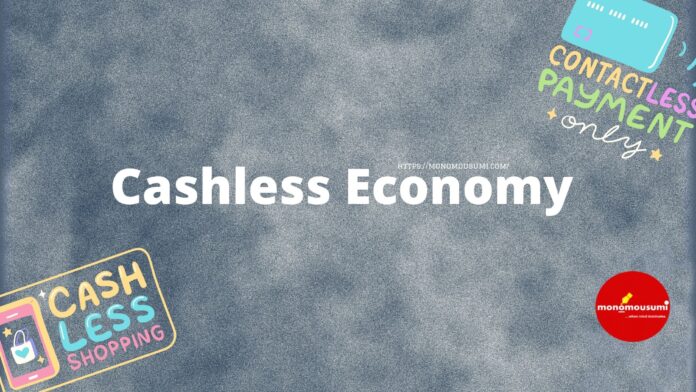Cashless economy is in the boom. People now and then hear about cashless economy and yet plethora of people are unaware of the term. Often times people are using the cashless form in their transaction but are unaware of this. This poses a major problem in completely transforming a nation’s economy into cashless economy.
What is Cashless Economy?
Cashless economy is a term where the flow of currency or transactions are done through credit cards, debit cards, internet banking, mobile banking, and e-wallets. All these transactions are done through electronic means, and no physical cash in involved or exchanged between both the parties involved in transaction. These type of transactions converts the nation’s economy into cashless economy. Other than aforementioned form of transactions, there also exists National Electronic Fund Transfer (NEFT), Real Time Gross Settlement (RTGS), or Immediate Payment Service (IMPS). IMPS is only limited to India.
Where did Cashless Economy emerged from?
Cashless economy may sound modern world phenomenon. But many people will astound after knowing that cashless economy is in existing since 8000 years ago in one form or another. Here is the history of cashless economy in brief below and its journey through the time to the point it reached today.
Barter System is one of the oldest form of cashless economy that existed. Barter system in a concept in which people exchange goods or commodities in order to render certain services. This exchange can be anything including grains, live stocks, land, or any other commodity which holds certain value. Both the parties would come to an agreement and exchange was done to avail various services. Though the system still exists today, but it is fading with the time.
After the barter system, came the time of cheques in 14th century. The rise of usage of cheques in 14th century was on boom. It is because carrying cheque was convenient rather than carrying currency or gold coins. 17th century witnessed the first hand written cheque and became quite popular after that. People saw convenience in carrying cheques, and it was light on the pocket instead of heavy gold or silver coins which was considered as currency in the time.
Printed cheque books were regulated in late 18th century, but it was time for cashless economy’s form to step up. In the mid 19th century, a new concept was introduced which was named Wire Transfer. Bank transfers or wire transfers was the form of cashless economy where banks would exchange money without physically exchanging bills or cash. Western Union was the first widely used service for wire transfer in 1872. The principle behind Western Union was telegraph network. Once money was exchange at telegraph office, operator would send a message to another office and fund would be released to recipient.
As Western Union was still improving and upgrading, during 20th century banks started issuing plastic cards. The bank details would be embossed on the card and cheques were provided with it. These cards were known as cheque guarantee cards. In 1914, first metal card was provided by US Western Union allowing free deferred payments. The first breakthrough that availed complete cashless economy came with introduction of ATM card by Barclays. Mid 80s saw the boom in Point of Sale service where user could swipe his card for the payments.
21st century was the era where digital payments would make outstanding progress. With the introduction of Paypal in 2000 brought the world to awe. Paypal quickly became popular and was widely used for online payment across the globe due to its convenience. Paypal would gain profuse customers reaching millions in just mere decade. This made global impact as people saw it easy to use and advantageous. This engendered many other players in wireless payment to up their technology as well.
In current digital era, the payments has become quite popular and can be done with mobile phones. The overly use of mobiles phones has really upgraded the payment methods, and also helping in transforming cash-bound economy to cashless economy.
Which countries has adopted Cashless Economy?
Myriad of countries are adopting cashless economy due to its convenient nature and usage. Some countries are on the verge of completely going cashless in the coming year or two. Some of the following countries are top competitors in adopting cashless economy.
Sweden
The country to all ready to go cashless. Many citizens of Sweden do not carry cash and depends on cashless transactions, especially the younger generation.
Finland
Finland is one of the top country that is shifting to cashless transactions and economy. As the country only has 5.5 million of population, Finland is moving fast towards cashless economy.
China
Past 30 years has change and transformed completely, and China has really cemented as one of the emerging country in Asia. One of the most popular way of payment in China is through QR code.
South Korea
Competing along side with China is its neighbouring country, South Korea. Another Asian country emerging and adopting cashless economy. South Korea’s 1600 bank branches has stopped accepting cash.
United Kingdom
United Kingdom, and specifically London is really gearing up for tech upgrade. Digitalization of money has really stepped up the game to facilitate cashless economy.
India in race of Cashless Economy
India is not far behind in the race to adopt absolute cashless economy. India is already on the way to cut down on currency bills and cash. Credit card and debit cards are used on high rate for transaction in India. Furthermore, mobile applications like BHIM, PayTM, PhonePe, and Google Pay are widely used among the young and old generation to ensure a step up to cashless economy. India soon will be a major player in cashless economy.
Merits of Cashless Economy over Cash-based economy
The major advantage of cashless economy is it free nation from corruption. Cashless transactions are recorded and tax can be collected on those transactions unlike cash which is not recorded and can be hidden from government for tax evasion. Another advantage of cashless economy is less paper trail. Paper trails are always a problem and cash receipts produce plethora of paper trails, hence cashless economy is undoubtedly better than cash based economy. International payments can also be completed easily with the help of cashless economy.
To put it laconically, cashless economy is favourable for the growth of all the nations, and also reduces tedious job of collection physical bills. Governments are striving hard to make entire nation cashless to reduce corruption. This makes cashless economy a better factor as compared to cash-based economy.
By Akshay Lothe
















